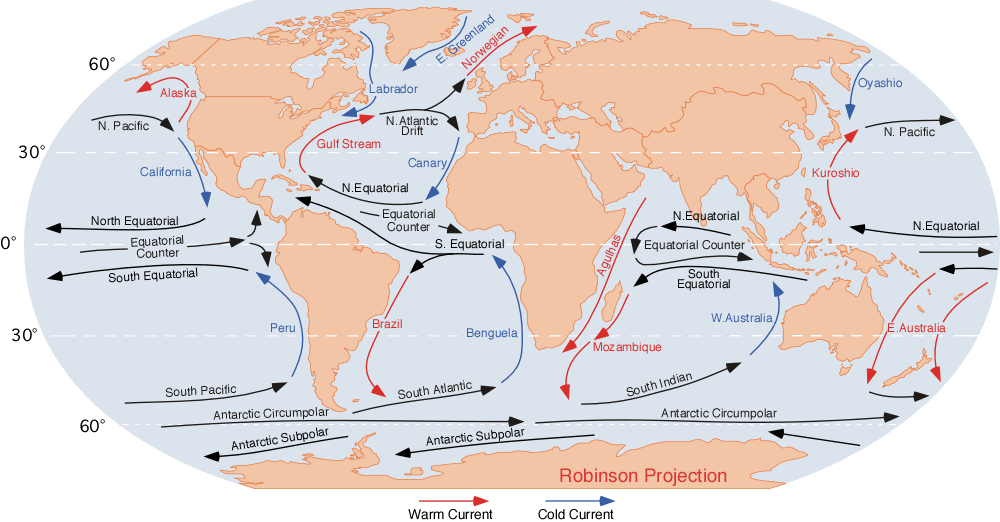|
Subsurface Ocean Current
A subsurface ocean current is an oceanic current that runs beneath surface currents. Examples include the Equatorial Undercurrents of the Pacific, Atlantic, and Indian Oceans, the California Undercurrent, and the Agulhas Undercurrent, the deep thermohaline circulation in the Atlantic, and bottom gravity currents near Antarctica. The forcing mechanisms vary for these different types of subsurface currents. Density current The most common of these is the density current, epitomized by the Thermohaline current. The density current works on a basic principle: the denser water sinks to the bottom, separating from the less dense water, and causing an opposite reaction from it. There are numerous factors controlling density. Salinity One is the salinity of water, a prime example of this being the Mediterranean/Atlantic exchange. The saltier waters of the Mediterranean sink to the bottom and flow along there, until they reach the ledge between the two bodies of water. At this point, th ... [...More Info...] [...Related Items...] OR: [Wikipedia] [Google] [Baidu] |
Ocean Current
An ocean current is a continuous, directed movement of seawater generated by a number of forces acting upon the water, including wind, the Coriolis effect, breaking waves, cabbeling, and temperature and salinity differences. Depth contours, shoreline configurations, and interactions with other currents influence a current's direction and strength. Ocean currents move both horizontally, on scales that can span entire oceans, as well as vertically, with vertical currents (upwelling and downwelling) playing an important role in the movement of nutrients and gases, such as carbon dioxide, between the surface and the deep ocean. Ocean currents flow for great distances and together they create the global conveyor belt, which plays a dominant role in determining the climate of many of Earth's regions. More specifically, ocean currents influence the temperature of the regions through which they travel. For example, warm currents traveling along more temperate coasts increase the temper ... [...More Info...] [...Related Items...] OR: [Wikipedia] [Google] [Baidu] |
Equatorial Undercurrent
The Cromwell Current (also called Pacific Equatorial Undercurrent or just Equatorial Undercurrent) is an eastward-flowing subsurface current that extends the length of the equator in the Pacific Ocean. The Cromwell Current was discovered in 1952 by Townsend Cromwell, a researcher with the Honolulu Laboratory of the Fish and Wildlife Service (later the United States Fish and Wildlife Service). It is wide and flows to the east. It is hidden under the surface of the Pacific Ocean at the equator The equator is the circle of latitude that divides Earth into the Northern Hemisphere, Northern and Southern Hemisphere, Southern Hemispheres of Earth, hemispheres. It is an imaginary line located at 0 degrees latitude, about in circumferen ... and is relatively shallow compared to other ocean currents being only from top to base. It is a powerful current with top velocities of up to 1.5 m/s (2.9 knots; 3.4 mph). The current's core coincides with the thermocline and its distance fr ... [...More Info...] [...Related Items...] OR: [Wikipedia] [Google] [Baidu] |
